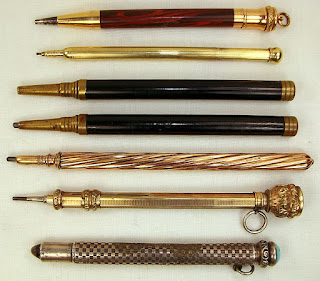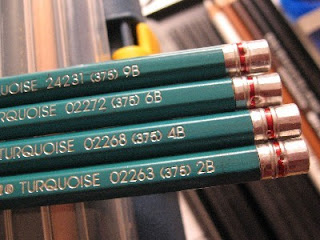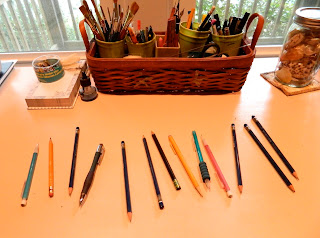 |
| Look at these fancy antique mechanical pencils! |
So as I’m working on my summer book project), I’m reminded about something my students ask me about a lot: how do you choose your PENCIL??
Well, as most of you know, artists rely on your good old-fashioned pencil for a lot of different art processes, even if its just for sketches or practice. What many people probably don’t realize is that the pencil as we know it was only invented around 1600, so for many thousands of years artists had to go without that handy tool. Before that artists used natural materials such as chalk, charcoal, sepia, or etching with sharp pointed tools to draw fine lines and sketches. It wasn’t until the late 1800’s that the pencil with an eraser on the end of the wooden shaft was designed and produced.
 |
| These are some of the more popular numbers used for drawing. |
Today, pencils are made with a mix of graphite and clay that controls the hardness of the material. Pencil hardness ranges from 9H (hardest) to 9B (softest). The softer the pencil, the darker and more smudgy your lines will be. Your standard writing/testing pencil, as my students should well know, is a 2B. By the way, pencils never contained actual lead inside, even though some artists’ paints have been known to contain lead. Lead hasn’t been used as a drawing material since Ancient Roman times.
Today, 14 billion pencils are made each year worldwide!! At least half of those are used in my art room (haha!). So, how does an artist choose the right pencil?
An artist should test many brands and types. There is not one type of pencil that works for everything. For example, I would not want a smudgy dark line for very architectural types of drawings. I would probably choose something in the H range or even a mechanical pencil with very skinny sized “lead”. If I were sketching a landscape or something that needed deep shading or textural effects, I’d probably use a very soft pencil (my favorite is the Ebony pencil that is somewhere softer than 6B depending on the brand). But I do I like a softer/thicker mechanical pencil if I am sketching outdoors or somewhere I can’t easily sharpen my pencil.
 |
| Ooooo look at all of my pencils! |
Don’t forget, the type of paper you are drawing on may effect how the pencil performs as well. And if you want to paint or add color to the drawing, very smudgy pencil can smear or make your colors muddy, so you’d want to use something that works well with your other media. I’d test the paper and media with the pencil before starting, or if you are a more experimental artist, just try it and see what happens.
Now, eraser or no eraser? That is the question. But that is for a later blog because erasers are a whole other beast! Until then, try out some pencils and find the ones that work for you and your art.





























